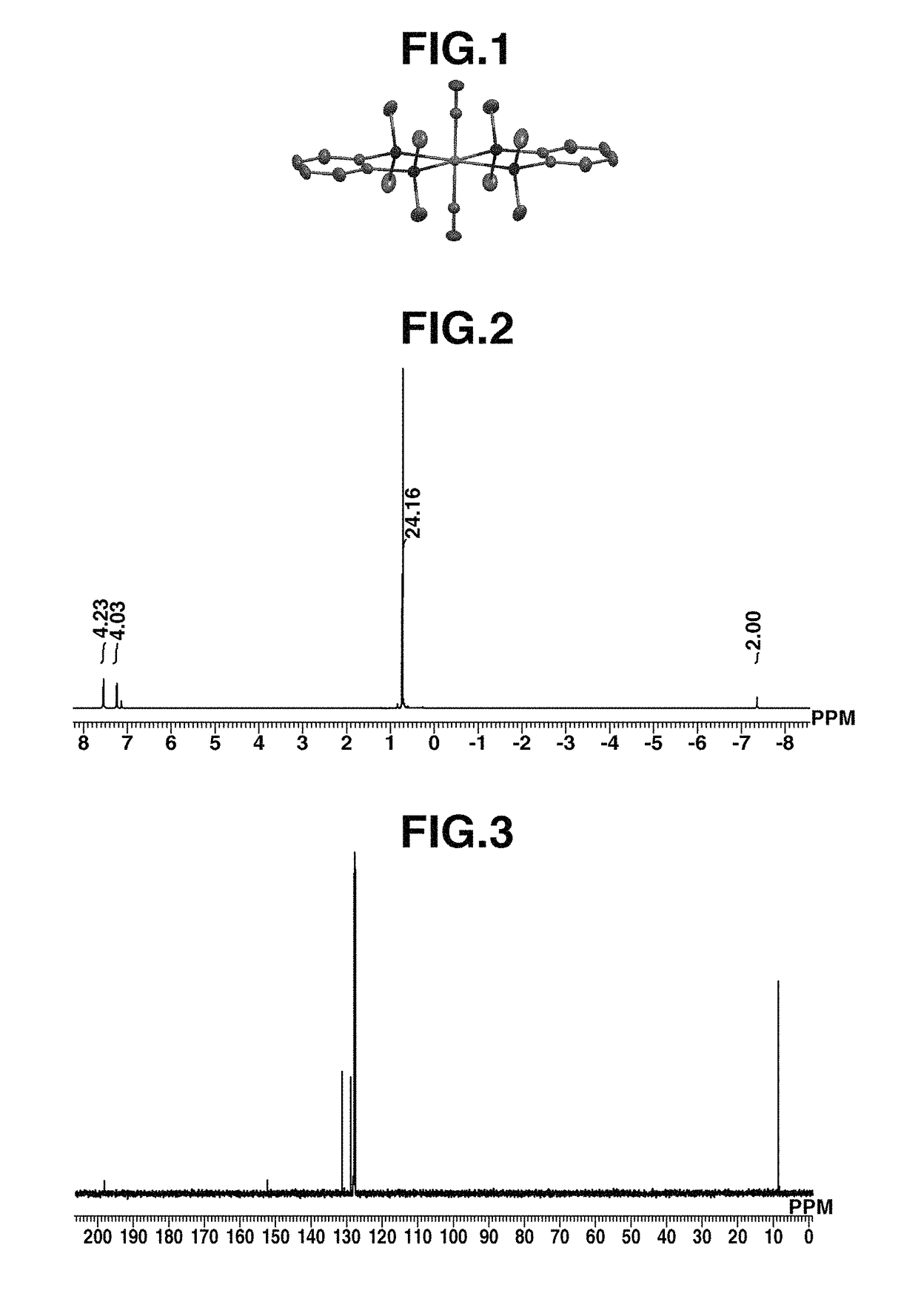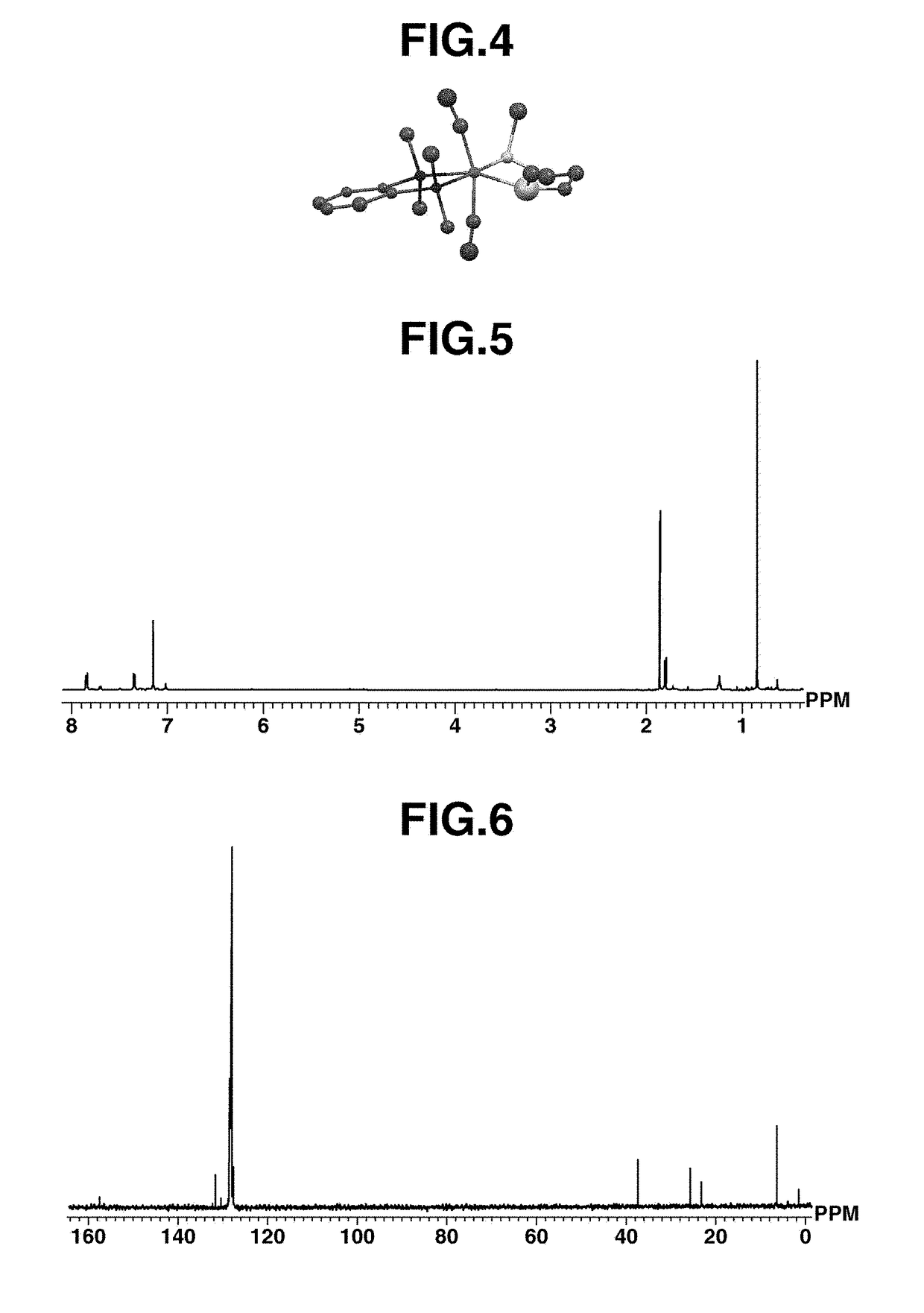Substituted mononuclear ruthenium complexes for catalysis of synthetic organic reactions
a technology synthetic organic reaction, which is applied in the field of mononuclear ruthenium complex, can solve the problems of low selectivity between - and -adducts, unreacted olefin is left in the addition product, and all pt, pd and rh as the center metal are very expensive noble metal elements, and achieve high catalytic activity
- Summary
- Abstract
- Description
- Claims
- Application Information
AI Technical Summary
Benefits of technology
Problems solved by technology
Method used
Image
Examples
example 1
Synthesis of Ruthenium Complex A
[0151]A 100-mL Schlenk tube under argon atmosphere was charged with (η4-1,3-cyclohexadiene)ruthenium(0) tricarbonyl complex (500 mg, 1.87 mmol) and 1,2-bis(dimethylsilyl)benzene (800 mg, 4.11 mmol), to which hexane (50 mL) which had been deaerated and dried was added. Under light irradiation using a high-pressure mercury lamp (UM-453B-A, 450 W, by Ushio Inc.), the contents were stirred at room temperature for 22 hours. After the completion of reaction, the reaction mixture was dried in vacuum. The dry product was dissolved in hexane (40 mL), from which a small amount of brown insoluble matter as by-product was removed by centrifugation. Thereafter, the hexane solution was concentrated under reduced pressure to about 25 mL. Subsequent recrystallization at −35° C. yielded ruthenium complex A (274 mg, 0.50 mmol, 27%) typically represented by formula (6). For the resulting ruthenium complex A, the geometry is shown in FIG. 1, the measurement results of 1H...
example 2
Synthesis of Ruthenium Complex B
[0157]In a 50-mL Schlenk tube under argon atmosphere, ruthenium complex A (100 mg, 0.18 mmol) was dissolved in toluene (20 mL) which had been deaerated and dried, to which 2,6-dithiaheptane (26 mg, 0.19 mmol) was added. The contents were stirred at room temperature for 12 hours. After the completion of reaction, the reaction mixture was dried in vacuum. The dry product was dissolved in diethyl ether (10 mL). Thereafter, the solution was concentrated under reduced pressure to about 5 mL. Subsequent recrystallization at −35° C. yielded ruthenium complex B (82 mg, 0.17 mmol, 94%) typically represented by formula (7). For the resulting ruthenium complex B, the geometry is shown in FIG. 4, the measurement results of 1H-NMR in FIG. 5, and the measurement results of 13C-NMR in FIG. 6.
[0158]1H NMR (CDCl3, 395 MHz): δ=0.82 (s, 12H, SiMe2), 1.24 (quint, 2H, —CH2CH2CH2—), 1.81 (t, 4H, —CH2CH2CH2—), 1.87 (s, 6H, Sme), 7.32-7.38 (m, 2H, C6H4), 7.83-7.87 (m, 2H, C6...
example 3
Hydrosilylation of 2-octene with 1,1,1,3,3-pentamethyldisiloxane
[0162]A 20-mL Schlenk tube equipped with a magnetic stirrer was heat dried while pumping to a vacuum of 5 Pa before its interior was purged with argon atmosphere. Into the Schlenk tube, ruthenium complex A (8 mg, 0.015 mmol) was admitted as catalyst. To the tube, 1-octene (78.2 μL, 0.5 mmol) was added, after which 1,1,1,3,3-pentamethyldisiloxane (97.6 μL, 0.5 mmol) was added. The solution was stirred at 80° C. for 3 hours. The solution was cooled, to which anisole (108.6 μL, 1.0 mmol, the amount used is identical hereinafter) was added as internal standard. By 1H-NMR spectroscopy, the geometry and yield of the product were determined. The results are shown as Entry 1 in Table 1.
[0163]1H NMR (400 MHz, CDCl3): δ=0.03 (s, 6H, Si(CH3)2), 0.06 (s, 9H, Si(CH3)3), 0.45-0.55 (m, 2H, SiCH2), 0.88 (t, JHH=7.2 Hz, 3H, CH2CH3), 1.20-1.34 (m, 12H, (CH2)6).
PUM
| Property | Measurement | Unit |
|---|---|---|
| temperature | aaaaa | aaaaa |
| temperature | aaaaa | aaaaa |
| temperature | aaaaa | aaaaa |
Abstract
Description
Claims
Application Information
 Login to View More
Login to View More - R&D
- Intellectual Property
- Life Sciences
- Materials
- Tech Scout
- Unparalleled Data Quality
- Higher Quality Content
- 60% Fewer Hallucinations
Browse by: Latest US Patents, China's latest patents, Technical Efficacy Thesaurus, Application Domain, Technology Topic, Popular Technical Reports.
© 2025 PatSnap. All rights reserved.Legal|Privacy policy|Modern Slavery Act Transparency Statement|Sitemap|About US| Contact US: help@patsnap.com



